Stamp: Royal Yacht, The Victoria and Albert 1 Surcharged (Seychelles 1983)
Royal Yacht, The Victoria and Albert 1 Surcharged (Seychelles 1983)
28 December (Seychelles ) within release Royal Wedding goes into circulation Stamp Royal Yacht, The Victoria and Albert 1 Surcharged face value 50 Seychellois cent
| Stamp Royal Yacht, The Victoria and Albert 1 Surcharged in catalogues | |
|---|---|
| Michel: | Mi: SC 544 |
| Stamp Number: | Sn: SC 528 |
| Stanley Gibbons: | Sg: SC 573 |
Stamp is square format.
Also in the issue Royal Wedding:
- Stamp - Prince Charles & Lady Diana Surcharged face value 2.25;
- Stamp - Prince Charles & Lady Diana Surcharged face value 3.75;
- Stamp - Prince Charles and Lady Diana Spencer Surcharged face value 50;
- Stamp - Royal Yacht, "Britannia" Surchrged face value 3.75;
- Stamp - Royal Yacht, "Cleveland" Surcharged face value 2.25;
- Stamp - Royal Yacht, The Victoria and Albert 1 Surcharged face value 50;
Stamp Royal Yacht, The Victoria and Albert 1 Surcharged it reflects the thematic directions:
A prince is a male ruler (ranked below a king, grand prince, and grand duke) or a male member of a monarch's or former monarch's family. Prince is also a title of nobility (often highest), often hereditary, in some European states. The female equivalent is a princess. The English word derives, via the French word prince, from the Latin noun prīnceps, from primus (first) and caput (head), meaning "the first, foremost, the chief, most distinguished, noble ruler, prince"
Princess is a title used by a female member of a monarch's family or by a female ruler. The male equivalent is a prince (from Latin princeps, meaning principal citizen). Most often, the term has been used for the consort of a prince, or for the daughter of a monarch. A crown princess can be the heiress apparent to the throne or the spouse of the heir apparent.
A Royalty is the immediate family of a king or queen regnant, and sometimes his or her extended family. The term imperial family appropriately describes the family of an emperor or empress, and the term papal family describes the family of a pope, while the terms baronial family, comital family, ducal family, grand ducal family, or princely family are more appropriate to describe the relatives of a reigning baron, count, duke, grand duke, or prince. However, in common parlance members of any family which reigns by hereditary right are often referred to as royalty or "royals." It is also customary in some circles to refer to the extended relations of a deposed monarch and his or her descendants as a royal family. A dynasty is sometimes referred to as "the House of ...". As of July 2013, there are 26 active sovereign monarchies in the world who rule or reign over 43 countries in all
A modern sailing ship or sailship is any large wind-powered vessel. Traditionally a sailing ship (or simply ship) is a sailing vessel that carries three or more masts with square sails on each. Large sailing vessels that are not ship-rigged may be more precisely referred to by their sail rig, such as schooner, barque (also spelled "bark"), brig, barkentine, brigantine or sloop. There are many different types of sailing ships, but they all have certain basic things in common. Every sailing ship has a hull, rigging and at least one mast to hold up the sails that use the wind to power the ship. The crew who sail a ship are called sailors or hands. They take turns to take the watch, the active managers of the ship and her performance for a period. Watches are traditionally four hours long. Some sailing ships use traditional ship's bells to tell the time and regulate the watch system, with the bell being rung once for every half hour into the watch and rung eight times at watch end (a four-hour watch). Ocean journeys by sailing ship can take many months, and a common hazard is becoming becalmed because of lack of wind, or being blown off course by severe storms or winds that do not allow progress in the desired direction. A severe storm could lead to shipwreck, and the loss of all hands. Sailing ships are limited in their maximum size compared to ships with heat engines, so economies of scale are also limited. The heaviest sailing ships (limited to those vessels for which sails were the primary means of propulsion) never exceeded 14,000 tons displacement. Sailing ships are therefore also very limited in the supply capacity of their holds, so they have to plan long voyages carefully to include many stops to take on provisions and, in the days before watermakers, fresh water.
Special Occasions





